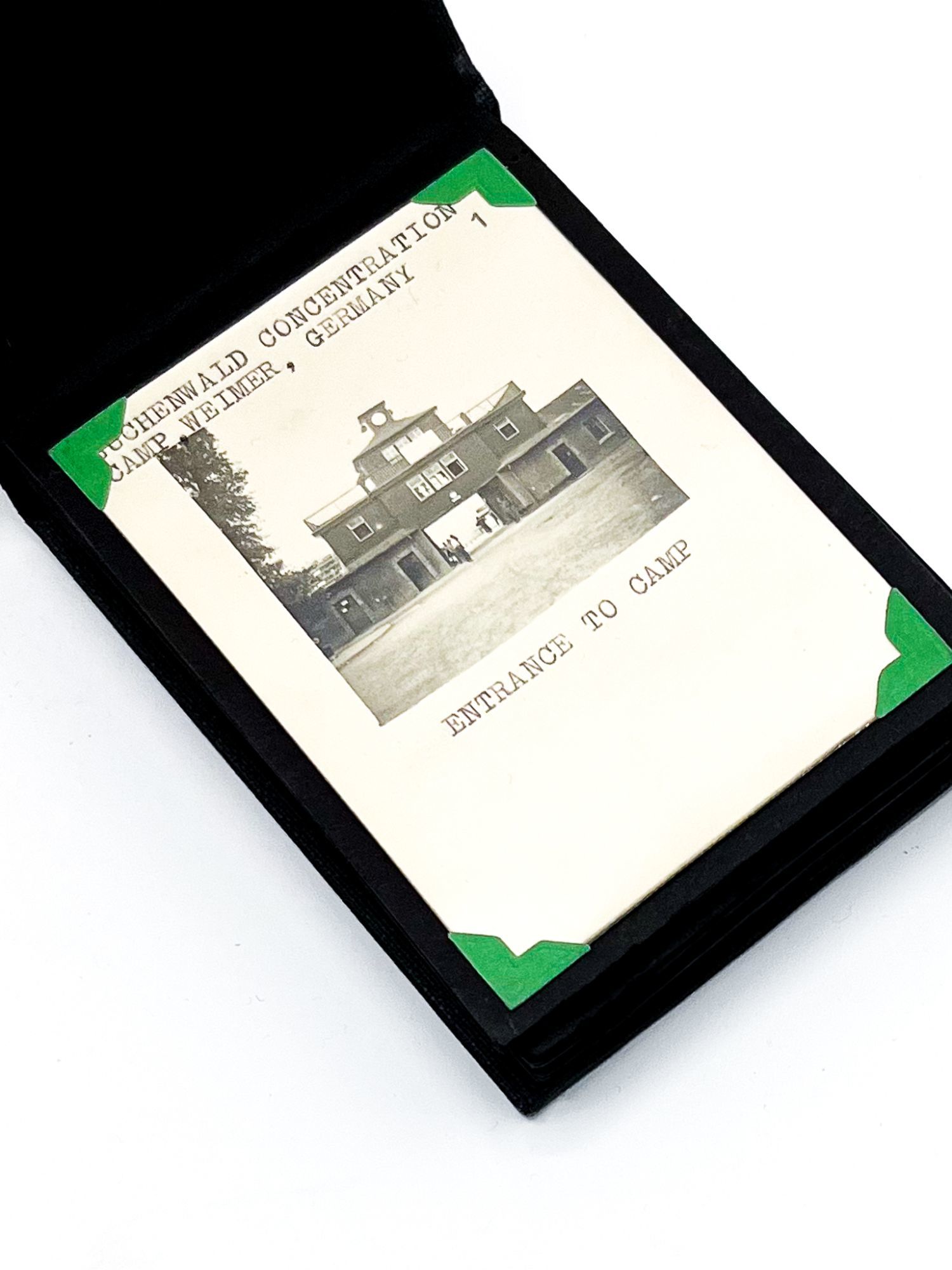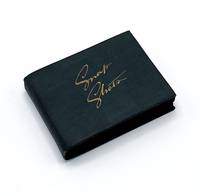Vernacular Photograph Album of Post-Liberation Buchenwald
- SIGNED
- n.p.: n.p., 1945
n.p.: n.p., 1945. Near fine.. Original annotated photograph album of the Buchenwald concentration camp compiled by an anonymous American G.I. soon after liberation. General Dwight D. Eisenhower's deep horror upon visiting the recently liberated concentration camps in April 1945 prompted his command to Allied forces to "let the world see." Soon thereafter the camps were documented in extensive detail by "scores of photographers, professional, semi-professional, and amateur as well as soldiers bearing cameras" (Barbie Zelizer). Many in the US and in the UK had long remained skeptical of the atrocities' extent until photos such as these were published or brought home. They were the first visual evidence of the Holocaust to be seen by the Anglo-American world, and rapidly became the undeniable evidence of what was until then only reported in speculative accounts. Indeed, such camp liberation photographs were groundbreaking in the history of photography insofar as they were themselves evidence, presenting an overwhelming crime that was irreducible to any verbal explanation.
This album — whose contact prints suggest development in a combat lab rather than a Stateside commercial processor — presents an uncommonly unified and almost narrative soldier's-eye-view of the aftermath. Violence permeates the album, though largely through environmental implications than corporeal evidence. After three snaps of the entrance of the camp, the photographer features the gallows, from which the typed caption tell us "six prisoners were hung at one time." Another photograph is captioned: "SEWER used to dispose of dead bodies. This was used only when too many were dying, and they couldn't take care of them with the Furnaces." The photographer also notes the bloodstained front step of the "DEATH HOUSE" in photo 16. Other subjects documented include the observation tower, camp posters, the operating room, the barracks, sleeping quarters, the ablution room, as well as the unidentified smiling face of a former inmate that ends the album.
Based on the helmet markings of other soldiers present in the photos, the compiler was likely a member of the 8th Armored Division, which liberated the Halberstadt-Zwieberge subcamp of Buchenwald in April 1945. These photos, however, were likely taken some weeks later, after most prisoners had departed and some cleanup had commenced. Nevertheless, while we've previously sold collections of press and official Army Signal Corp photographs, this is the first vernacular collection by a single soldier documenting the camps that we've handled.
A harrowing and primary record of the Holocaust from an uncommon point of view. 4'' x 3'' (photographs); 3.5'' x 4.5'' (leaves). Black cloth commercial album with gilt lettering ("Snap Shots") to front. 19 black-and-white contact print photographs, corner mounted recto only (final two re-mounted with clear archival corners), all with captions typewritten in and around the photo borders. [38] leaves in total. Photos a touch curled; gutter starting a bit to a couple openings, but firm. Overall, clean and sound.
This album — whose contact prints suggest development in a combat lab rather than a Stateside commercial processor — presents an uncommonly unified and almost narrative soldier's-eye-view of the aftermath. Violence permeates the album, though largely through environmental implications than corporeal evidence. After three snaps of the entrance of the camp, the photographer features the gallows, from which the typed caption tell us "six prisoners were hung at one time." Another photograph is captioned: "SEWER used to dispose of dead bodies. This was used only when too many were dying, and they couldn't take care of them with the Furnaces." The photographer also notes the bloodstained front step of the "DEATH HOUSE" in photo 16. Other subjects documented include the observation tower, camp posters, the operating room, the barracks, sleeping quarters, the ablution room, as well as the unidentified smiling face of a former inmate that ends the album.
Based on the helmet markings of other soldiers present in the photos, the compiler was likely a member of the 8th Armored Division, which liberated the Halberstadt-Zwieberge subcamp of Buchenwald in April 1945. These photos, however, were likely taken some weeks later, after most prisoners had departed and some cleanup had commenced. Nevertheless, while we've previously sold collections of press and official Army Signal Corp photographs, this is the first vernacular collection by a single soldier documenting the camps that we've handled.
A harrowing and primary record of the Holocaust from an uncommon point of view. 4'' x 3'' (photographs); 3.5'' x 4.5'' (leaves). Black cloth commercial album with gilt lettering ("Snap Shots") to front. 19 black-and-white contact print photographs, corner mounted recto only (final two re-mounted with clear archival corners), all with captions typewritten in and around the photo borders. [38] leaves in total. Photos a touch curled; gutter starting a bit to a couple openings, but firm. Overall, clean and sound.



